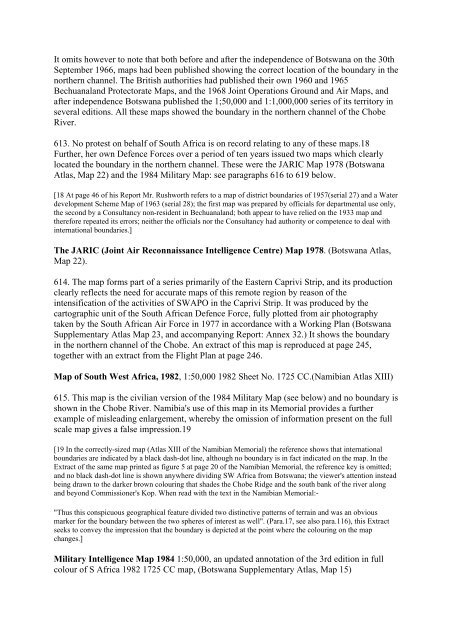botswana/namibia - Cour international de Justice
botswana/namibia - Cour international de Justice
botswana/namibia - Cour international de Justice
Create successful ePaper yourself
Turn your PDF publications into a flip-book with our unique Google optimized e-Paper software.
It omits however to note that both before and after the in<strong>de</strong>pen<strong>de</strong>nce of Botswana on the 30th<br />
September 1966, maps had been published showing the correct location of the boundary in the<br />
northern channel. The British authorities had published their own 1960 and 1965<br />
Bechuanaland Protectorate Maps, and the 1968 Joint Operations Ground and Air Maps, and<br />
after in<strong>de</strong>pen<strong>de</strong>nce Botswana published the 1;50,000 and 1:1,000,000 series of its territory in<br />
several editions. All these maps showed the boundary in the northern channel of the Chobe<br />
River.<br />
613. No protest on behalf of South Africa is on record relating to any of these maps.18<br />
Further, her own Defence Forces over a period of ten years issued two maps which clearly<br />
located the boundary in the northern channel. These were the JARIC Map 1978 (Botswana<br />
Atlas, Map 22) and the 1984 Military Map: see paragraphs 616 to 619 below.<br />
[18 At page 46 of his Report Mr. Rushworth refers to a map of district boundaries of 1957(serial 27) and a Water<br />
<strong>de</strong>velopment Scheme Map of 1963 (serial 28); the first map was prepared by officials for <strong>de</strong>partmental use only,<br />
the second by a Consultancy non-resi<strong>de</strong>nt in Bechuanaland; both appear to have relied on the 1933 map and<br />
therefore repeated its errors; neither the officials nor the Consultancy had authority or competence to <strong>de</strong>al with<br />
<strong>international</strong> boundaries.]<br />
The JARIC (Joint Air Reconnaissance Intelligence Centre) Map 1978. (Botswana Atlas,<br />
Map 22).<br />
614. The map forms part of a series primarily of the Eastern Caprivi Strip, and its production<br />
clearly reflects the need for accurate maps of this remote region by reason of the<br />
intensification of the activities of SWAPO in the Caprivi Strip. It was produced by the<br />
cartographic unit of the South African Defence Force, fully plotted from air photography<br />
taken by the South African Air Force in 1977 in accordance with a Working Plan (Botswana<br />
Supplementary Atlas Map 23, and accompanying Report: Annex 32.) It shows the boundary<br />
in the northern channel of the Chobe. An extract of this map is reproduced at page 245,<br />
together with an extract from the Flight Plan at page 246.<br />
Map of South West Africa, 1982, 1:50,000 1982 Sheet No. 1725 CC.(Namibian Atlas XIII)<br />
615. This map is the civilian version of the 1984 Military Map (see below) and no boundary is<br />
shown in the Chobe River. Namibia's use of this map in its Memorial provi<strong>de</strong>s a further<br />
example of misleading enlargement, whereby the omission of information present on the full<br />
scale map gives a false impression.19<br />
[19 In the correctly-sized map (Atlas XIII of the Namibian Memorial) the reference shows that <strong>international</strong><br />
boundaries are indicated by a black dash-dot line, although no boundary is in fact indicated on the map. In the<br />
Extract of the same map printed as figure 5 at page 20 of the Namibian Memorial, the reference key is omitted;<br />
and no black dash-dot line is shown anywhere dividing SW Africa from Botswana; the viewer's attention instead<br />
being drawn to the darker brown colouring that sha<strong>de</strong>s the Chobe Ridge and the south bank of the river along<br />
and beyond Commissioner's Kop. When read with the text in the Namibian Memorial:-<br />
"Thus this conspicuous geographical feature divi<strong>de</strong>d two distinctive patterns of terrain and was an obvious<br />
marker for the boundary between the two spheres of interest as well". (Para.17, see also para.116), this Extract<br />
seeks to convey the impression that the boundary is <strong>de</strong>picted at the point where the colouring on the map<br />
changes.]<br />
Military Intelligence Map 1984 1:50,000, an updated annotation of the 3rd edition in full<br />
colour of S Africa 1982 1725 CC map, (Botswana Supplementary Atlas, Map 15)

















